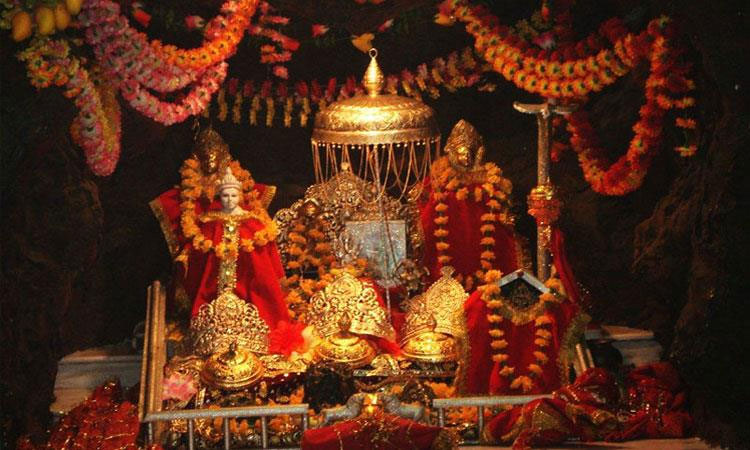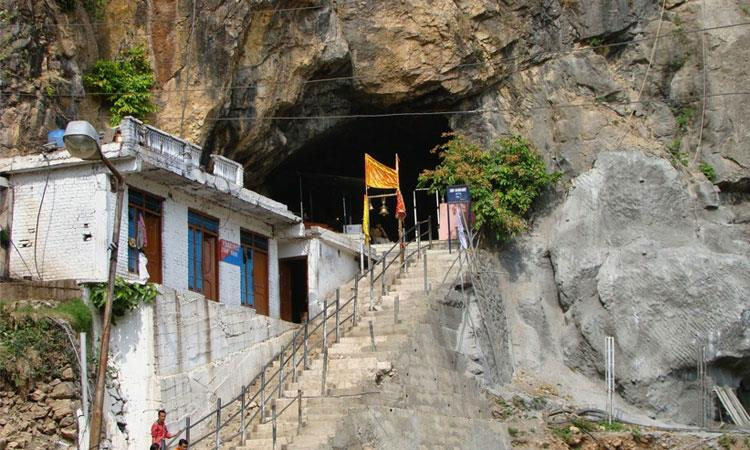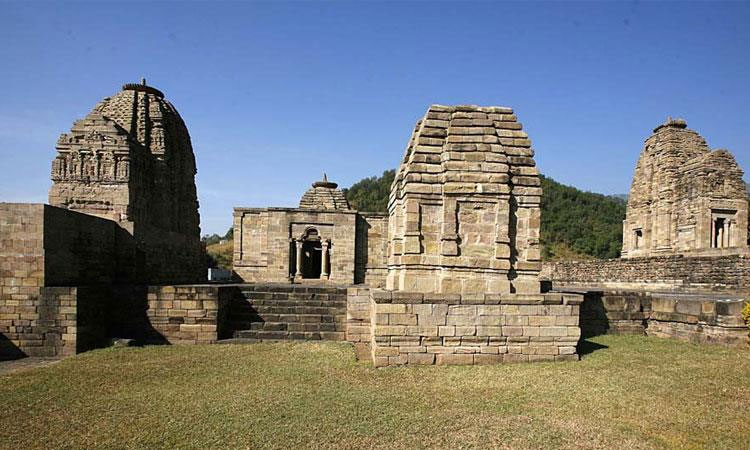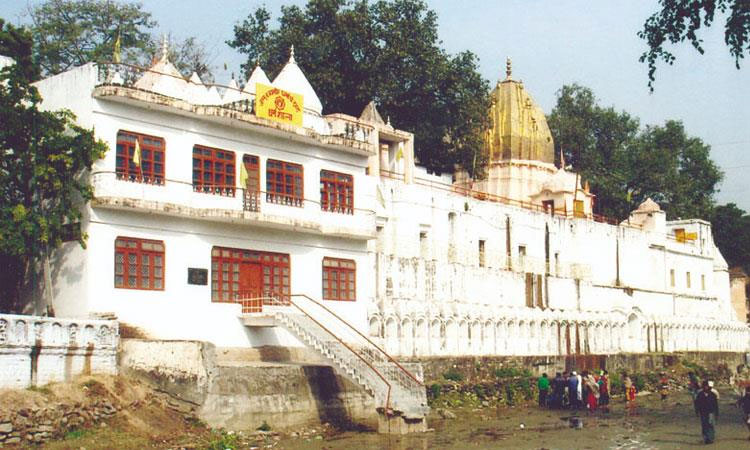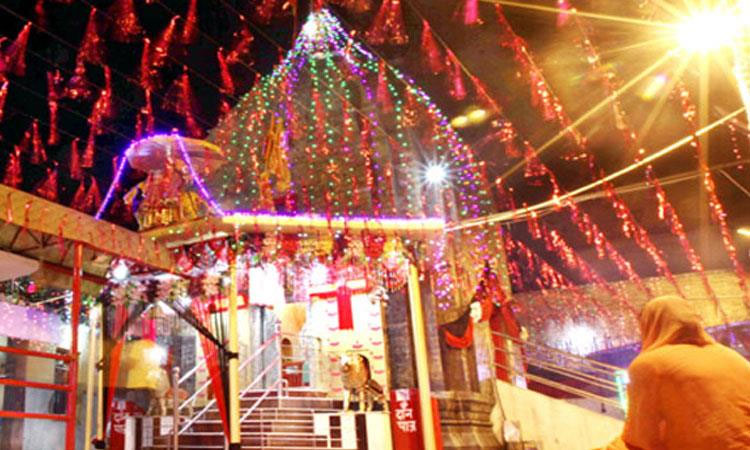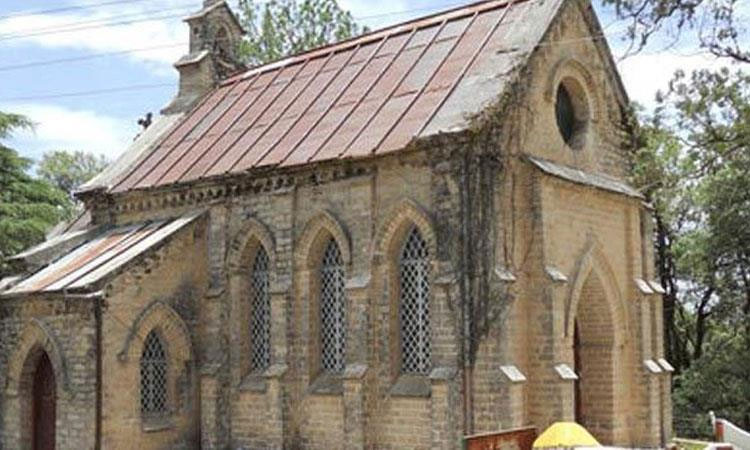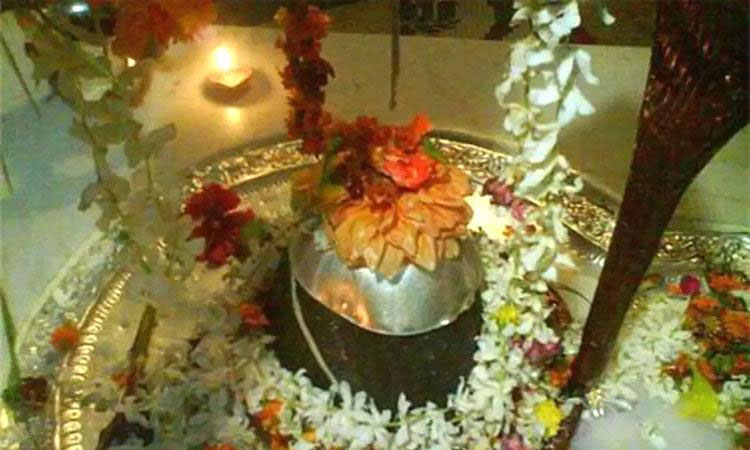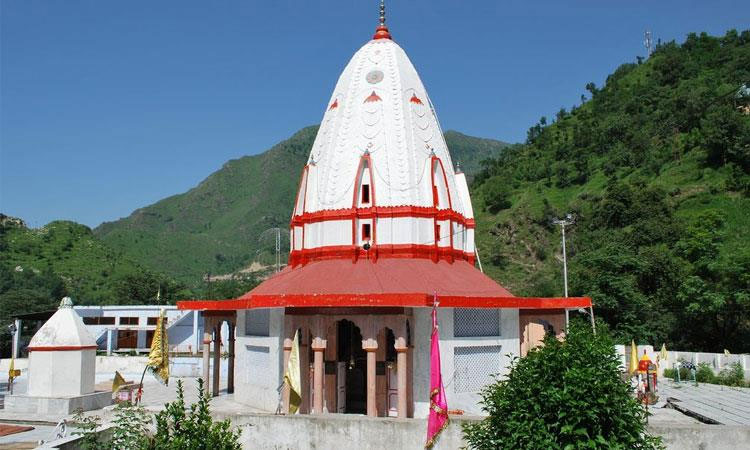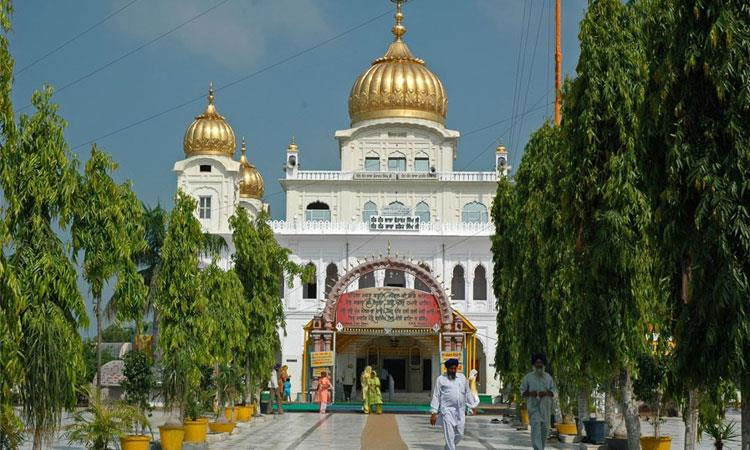Pilgrimages In JammuJammu -The city of Temples....
Mata Vaishno Devi
The town of Katra, which is close to Jammu, contains the Vaishno Devi shrine. Nestling on top of the Trikuta Hills at a height of 1700 m is the sacred cave shrine of Vaishno Devi, the mother goddess.
At a distance of 48 km from Jammu, the cave is 30 m long and just 1.5 m high. At the end of the cave are shrines dedicated to the three forms of the mother goddessâ€â€ÂMahakali, Mahalakshmi and Mahasarasvati.
Pilgrims start trekking to the cave temple, which is 13 km from Katra, enter in small groups through a narrow opening and walk through ice-cold waters to reach the shrines.
According to legend, the mother goddess hid in the cave while escaping a demon whom she ultimately killed.
Pur Mandal
Pur Mandal, also known as Chota Kashi, is located 35 km from Jammu city. An ancient holy place, it has several temples of Shiva and other deities.
On Shivratri, the town wears a festive look and for three days as people celebrate the marriage of Lord Shiva to Goddess Parvati.
The people of Jammu also come out in their full best to celebrate Shivratri at Peer Khoh Cave Temple, the Ranbireshwar Temple and the Panjbhaktar Temple. In fact, if one visits Jammu during Shivratri, one finds a celebration going on almost everywhere.
Bawey Wali Mata
In Jammu in the state of Jammu & Kashmir in India. The temple of Maha Kali (better known as Bahu or Bawey Wali Mata), located in the Bahu Fort, is considered second only to Mata Vaishno Devi in terms of mystical power. The temple was built shortly after the coronation of Maharaja Gulab Singh in 1822.
The famous temple of Bawey Wali Mata is inside the Bahu Fort where, every Tuesday and Sunday, pilgrims throng to worship the goddess. Positioned along the banks of river Tawi, the impressive construction of Bahu Fort is probably the oldest construction in Jammu.
Ranbireshwar Temple
Depicting the art and architecture of 1883, the Ranbireshwar Temple is dedicated to Lord Shiva. Offering a marvellous view of isolated forested hills, the temple is located on Shalimar Road, near the new Secretariat, opposite the Dogra Art Gallery in Jammu. Standing 75 metres high, the temple itself is a local landmark.
The temple was built by Raja Ranbir Singh, a great devotee of Lord Shiva. He established a seven-and-a-half feet high crystal Lingam in the temple, which of course, is the major attraction. Apart fropm the main Shiva-Lingam, there are twelve other Shiva-lingams of crystal measuring from 15 to 38 inches.
Mahamaya Temple
Jammu rightly deserves the sobriquet 'City of Temples'. It consists of a large number of temples that are thronged by a huge number of pilgrims at different times of the year. Temple towers dominate its skyline. Mahamaya Temple in Jammu is one such temple which is flocked by devotees who come to offer their prayers.
However the Mahamaya Temple is not merely a place of worship, it is one of the foremost tourist attractions of Jammu. One of the distinctive characteristic of the Mahamaya Temple is that its presiding deity is not any famous God of the Hindu Pantheon but Mahamaya, a Dogra heroine.
Gurdwara Shri Guru Nanak Dev Ji
This historical Gurdwara is built to mark the visit of Guru Nanak Sahib. It is situated near historical Mubarak Mandi Complex of Dogra rulers near Chowk Chabootra Jammu. It is said that Guru Sahib while returning to punjab via Kashmir stayed here. In this small Gurudwara there is a 3 feet marbled statue of Guru Nanak Dev ji installed by Rajput Raja Maharaja Partap Singh.
During Singh Sabha Movement when statues were removed from Gurdwaras this statue got unnoticed thus got intact. Very few people know about this statue. Gurdwara Shri Guru Nanak Devji is an important religious site of the Jammu and Kashmir pilgrim tourism.
Raghunath Temple
Raghunath Temple was built by Maharaja Ranbir Singh during the period from 1822-1860. It is located at Sui which is about 8 kilometers away from the main capital city of Jammu. The temple has a total of seven shrines with a Shikhara. It is one of the largest temples in the entire northern India.There are statues of many Gods in the temple. The main deity in the temple is Rama; Vishnu's avatar. The other idols include Ganesh Ji, Lord Krishna, and eminent Hindu deities.
The architecture of temple reflects the Mughal architectural style. There are spiral gold plated towers. The cluster of temples in the nearby area (all dedicated to the Gods and Goddesses related to the epic Ramayana) makes it the largest temple complex in North India.
Protestant Church
The Protestant church on Wazarat road is the oldest Church in the Jammu city.
The city has a number of historic churches. Of them Protestant church on Wazarat road is the oldest Church in the city of temples.Other Churches are Roman Catholic Church near Jewel Chowk and Presentation Church of Virgin Mary. Another Church is St. Mary Church on G.L.Dogra road.
Shahdara Sharif
One of the most popular Muslim shrines in Jammu, Shahdra-Sharif is situated in Rajouri district and is approximately 177 km from Jammu. The shrine is dedicated to Baba Ghulam Shah Badshah and dates back to the 19th century. Standing atop a beautiful hillock in Thanna Mandi area, 29 km from Rajouri town, Shahdra Sharif has quite a story attached to it.
It is believed that Gulab Singh, once the army general of Maharaja Ranjit Singh of Punjab, got this shrine constructed. The shrine is located in Rajouri district (approximately 177 km from Jammu). Regular bus services as well as Taxis are available from Rajouri as well as Jammu.
Peer Khoh
The Shrine of the Peer Khoh Temple is one of the old temples of 'The City of Temples'. A large number of devotees throng it on Puranmashi, Amavasya and Ekadashi. The important festivals held here are Shivratri, Purnima amd Shravan Puranmashi or Raksha Bandhan. The lingam is located inside a small but peaceful cave embellished with white marble rectangular platform.
The black stone lingam is decorated with a copper snake or Naga and a Silver sheet covers the Jallari or Yoni, topped by a copper vessel hanging to pour water continuously on the lingam. The Peer Kho Temple and Peer Mitha are two old temples located in the city of temples.
Ziarat Peer Mitha
Ziarat Peer Mitha is a mosque situated in the center of Jammu. It also houses the tomb of Pir Ziarat, who was popularly known as Peer Mitha. The ziarat came to be known by this name because he readily accepted even a pinch of sugar in the offerings. Shrine of Peer Mitha is a famous Muslim shrine in Jammu.
Peer Mitha was a contemporary of Ajaib Dev and Ghareeb Nath – both saints were famous for their prophecies and miracles. 'Mitha' means 'the sweet one', for the Peer would accept nothing more than a pinch of sugar in offering from his devotees.The holy shrine of Ziarat Peer Mitha imparts an aesthetic appeal to the entire surrounding.
Shiv Khori
Shivkhori is a famous cave shrine of Hindus devoted to lord Shiva, situated in the Reasi district of Jammu & Kashmir.Khori means cave (Guffa) and Shiv Khori thus denotes Shiva's cave. This natural cave is about 200 metres long, one metre wide and two to three metres high and contains a self made lingam, which according to the people is unending.
The first entrance of the cave is so wide that 300 devotees can be accommodated at a time. Its cavern is spacious to accommodate large number of people. The inner chamber of the cave is smaller. The passage from outer to the inner chamber is low and small, at one spot it divides itself into two parts. One of these is believed to have led to Kashmir where Swami Amarnath cave is located. Inside a naturally created image of Lord Shiva, about 4 metres high, is visible.
Chichi Mata
It is situated near Samba and is popularly known as Pehla Darshan of Vaishno Devi pilgrims. One of the prominent religious sites of Jammu and Kashmir, Chichi Mata is generally believed to be the gateway to the temple of Vaishno Devi. Commonly said to be the Pehla Darshan of the pilgrims of Vaishno Devi, Chichi Mata commands an important position in the religious ancestry of the state.
The visit to the holy shrine of Vaishno Devi is incomplete without the visit to the famous religious monument of Chichi Mata. Far from the maddening crowd of the cities, the serene and calm surrounding of the sacred sanctorum of Chichi Mata fills the devotees with an intense sense of dedication and submission to the Eternal Being.
The ardent followers of Chichi Mata can experience the divine presence of the Supreme Power in the holy sanctorum of the temple.
Buddha Amarnath
Buddha Amarnath Temple, dedicated to Hindu deity Shiva, is one of the oldest shrines of Jammu region. It is located in the village of Rajpura in tehsil Mandi of Poonch district. The River Pulsata flows by the temple, is considered to be sacred where pilgrims take bath before entering to the temple. A mythological legend is associated with the river and it has been named after Rishi Pulsata, grandfather of Ravana.
Shivlinga of this temple is not naturally formed and made up of white stone. Buddha Amarnath shrine is older than the historical cave shrine of Amarnathji in Kashmir. This ancient temple is popularly known for Raksha Bandhan Mela and Chari Mubarak Yatra in which every year thousands of devotees from across India participate.
Krimchi Temple
A small village in Udhampur district, well-known for its mineral deposits, Krimchi is one of the main sites of some of the oldest temple complexes of Jammu.
Some of these temples are deemed to have been erected during the 11th-12th century. And according to myths, Raja Kichak was the originator of this place and the empire. One can scout many attractions of Krimchi which encompass the remnants of three very old shrines. These are the oldest temples in the northern state of Jammu and Kashmir. All of them are positioned on a stone complex and there is a small river close by which enhances its exquisiteness. All in all, it is worth paying a visit.
Dera Baba Banda
An ancient Gurdwara built over 300 years ago, Dera Baba Banda is nestled in the Reasi district of Katra and is devoted to Baba Banda Bahadur who was amongst the favorites of Guru Gobind Singh.
Baba Banda Bahadur was a Sikh military officer whose original name was 'Lachhman Das'. There is a lot to witness in the Gurudwars such as weapons, including a sword presented by Guru Gobind Singh. Other artifacts which have been put on display are wall paintings and Sikh flag made from deodar wood, constructed by Baba Banda Bahadur. And it entices throngs of Hindus and Sikhs from various parts of the globe every season.

